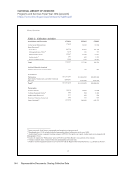70 Survey Results: Survey Questions and Responses
Setting and documenting policies for what is selected for the collection
Support of community decision-making
Teamwork, disciplinary analysis and duplicate analysis
The ability to execute change based on the analytics and having the resources and personnel to engage
consistently with the data.
The ability to quickly capture electronic usage statistics for quick analysis
The application of learned knowledge to administrative decision-making
The day-to-day work of selectors and technical services colleagues monitoring usage of electronic
resources may be the most consistently successful aspect. But the more elaborate projects comparing
holdings and collection activity with partner institutions have also been very important and successful
in supporting collaborative initiatives. Since this work takes place on so many different levels, it is
difficult to isolate parts.
The determinations to add to our collections or not, the determinations to de-accession or store off site,
and the prioritization of funding are all informed by our practices.
The efforts made by the Collections Development department to compile and present quantitative data
used to inform decision-making.
The high-level assessments can be helpful for large trends. Using Sustainable Collection Services has
been helpful for us to look at issues related to storage, which is different than what other libraries use it
for (which has more often been for deselection).
The library administration encourages ongoing collection assessment and has made it a priority.
The most successful parts of the collection assessment process are both formal and informal.
Informally, listening skills, dispelling myths of assessment, and showing actionable results no matter
how small have contributed to the success of collection assessment. Formally, clear support from
stakeholders (dean, associate deans, division heads) and productive collaborations have contributed to
the success of collection assessment.
The opportunity to examine collections in particular subject or discipline areas is the most successful
part of the collection assessment process.
The routine collection of usage statistics for collection evaluation, and the triennial survey of our users.
Understanding the usage patterns of our various constituencies.
Usage analysis
Usage data on e-journals is made available on a regular basis. All subject liaisons have the option to have
a personal login to the EBSCONET database to review usage data as needed. Reports from ILS are run
and delivered to subject liaisons as requested and in formats easy to use.
Using data to make decisions on which continuing resources should be renewed.
We annually report collections trends showing changes in collections and use over time. We use
assessment measures to select items for storage.
We can see the use evolve over time.
We have developed some good tools for presenting and contextualizing data.
57. If you could, what aspects or parts of the collection assessment process would you change? N=39
Better communication
Setting and documenting policies for what is selected for the collection
Support of community decision-making
Teamwork, disciplinary analysis and duplicate analysis
The ability to execute change based on the analytics and having the resources and personnel to engage
consistently with the data.
The ability to quickly capture electronic usage statistics for quick analysis
The application of learned knowledge to administrative decision-making
The day-to-day work of selectors and technical services colleagues monitoring usage of electronic
resources may be the most consistently successful aspect. But the more elaborate projects comparing
holdings and collection activity with partner institutions have also been very important and successful
in supporting collaborative initiatives. Since this work takes place on so many different levels, it is
difficult to isolate parts.
The determinations to add to our collections or not, the determinations to de-accession or store off site,
and the prioritization of funding are all informed by our practices.
The efforts made by the Collections Development department to compile and present quantitative data
used to inform decision-making.
The high-level assessments can be helpful for large trends. Using Sustainable Collection Services has
been helpful for us to look at issues related to storage, which is different than what other libraries use it
for (which has more often been for deselection).
The library administration encourages ongoing collection assessment and has made it a priority.
The most successful parts of the collection assessment process are both formal and informal.
Informally, listening skills, dispelling myths of assessment, and showing actionable results no matter
how small have contributed to the success of collection assessment. Formally, clear support from
stakeholders (dean, associate deans, division heads) and productive collaborations have contributed to
the success of collection assessment.
The opportunity to examine collections in particular subject or discipline areas is the most successful
part of the collection assessment process.
The routine collection of usage statistics for collection evaluation, and the triennial survey of our users.
Understanding the usage patterns of our various constituencies.
Usage analysis
Usage data on e-journals is made available on a regular basis. All subject liaisons have the option to have
a personal login to the EBSCONET database to review usage data as needed. Reports from ILS are run
and delivered to subject liaisons as requested and in formats easy to use.
Using data to make decisions on which continuing resources should be renewed.
We annually report collections trends showing changes in collections and use over time. We use
assessment measures to select items for storage.
We can see the use evolve over time.
We have developed some good tools for presenting and contextualizing data.
57. If you could, what aspects or parts of the collection assessment process would you change? N=39
Better communication




















































































































































































